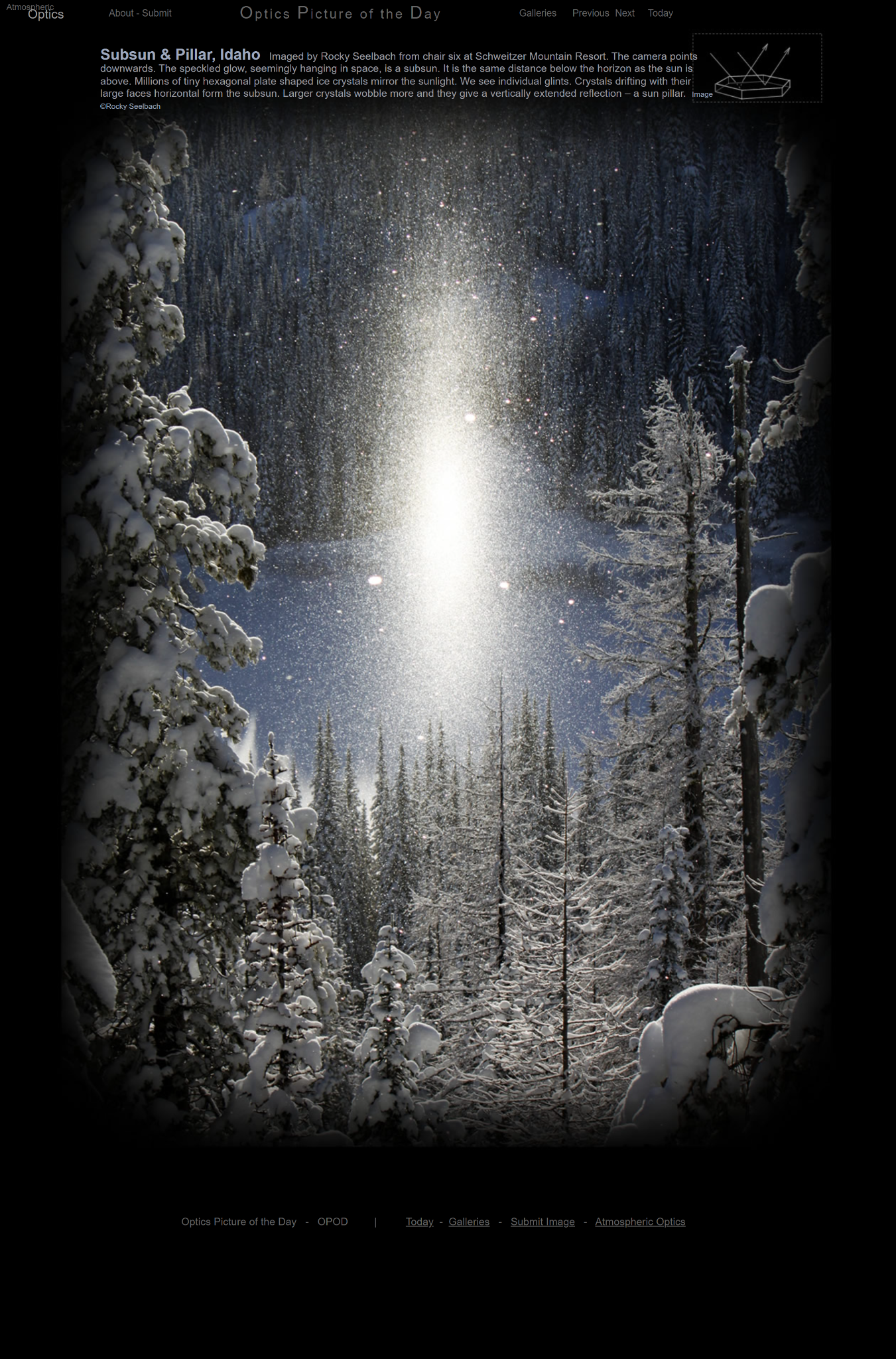Subsun, Idaho - OPOD
Subsun, Idaho: A Stunning Atmospheric Phenomenon
Have you ever witnessed a breathtaking optical display in the sky that left you in awe? One such phenomenon, known as a subsun, occurred in Idaho and was beautifully captured by photographer Rocky Seelbach. From his vantage point on chair six at Schweitzer Mountain Resort, Seelbach captured an image that showcased not only the subsun but also a sun pillar. This remarkable sight was caused by millions of tiny hexagonal plate-shaped ice crystals reflecting sunlight in a mesmerizing way.
Understanding the Subsun and Sun Pillar
The subsun is an optical phenomenon that appears as a speckled glow hanging in space, seemingly below the horizon. Interestingly, it is located at the same distance below the horizon as the sun is above. How does this happen? The answer lies in the presence of ice crystals in the atmosphere. These tiny hexagonal plate-shaped ice crystals act as mirrors, reflecting the sunlight. When we observe the subsun, we are actually seeing individual glints of light from these crystals.
As the ice crystals drift through the atmosphere, some of them align themselves with their large faces horizontal. These aligned crystals form the subsun, creating a mesmerizing spectacle for those fortunate enough to witness it. However, larger crystals tend to wobble more as they drift, resulting in a vertically extended reflection. This extended reflection is known as a sun pillar and adds an extra layer of beauty to the scene captured by Seelbach.
The Science Behind the Subsun and Sun Pillar
To truly appreciate the beauty of the subsun and sun pillar, it's important to understand the science behind these phenomena. The hexagonal shape of the ice crystals plays a crucial role in their ability to reflect sunlight. When sunlight passes through these crystals, it undergoes a process called refraction. This process causes the light to bend and separate into its component colors, creating a stunning display of colors in the sky.
The angle at which the sunlight enters and exits the ice crystals determines the shape and orientation of the subsun and sun pillar. When the crystals align themselves horizontally, they act as miniature mirrors, reflecting the sunlight in a way that creates the subsun. On the other hand, when the crystals wobble more due to their larger size, they create a vertically extended reflection, resulting in the sun pillar.
Capturing the Subsun and Sun Pillar
Photographing atmospheric optical phenomena like the subsun and sun pillar can be a challenging task. However, talented photographers like Rocky Seelbach have managed to capture these awe-inspiring moments for all to enjoy. Seelbach's image of the subsun and sun pillar in Idaho showcases not only his skill as a photographer but also the natural beauty of this rare phenomenon.
To capture such an image, photographers often rely on their knowledge of atmospheric optics and a keen eye for detail. They carefully select their vantage point, considering factors such as the angle of the sunlight and the position of the ice crystals in the atmosphere. Additionally, the use of specialized camera equipment and techniques can enhance the quality and clarity of the final image.
Conclusion
The subsun and sun pillar are captivating atmospheric optical phenomena that leave viewers amazed by the wonders of nature. In Idaho, photographer Rocky Seelbach beautifully captured these phenomena, showcasing their mesmerizing beauty. The presence of millions of tiny hexagonal plate-shaped ice crystals in the atmosphere creates a mirror-like effect, reflecting sunlight and creating glints of light that form the subsun. Larger ice crystals add an extra touch of magic with their vertically extended reflection, resulting in the sun pillar.
Understanding the science behind these phenomena adds another layer of appreciation for their beauty. The refraction of sunlight through the ice crystals causes it to bend and separate into its component colors, creating a stunning display of colors in the sky. Photographers like Seelbach skillfully capture these moments, allowing us to marvel at the wonders of the natural world.
Next time you find yourself gazing at the sky, keep an eye out for the possibility of witnessing a subsun or sun pillar. These rare and enchanting optical phenomena are a testament to the intricate beauty of our atmosphere and the mysteries it holds.
Subsun & Pillar, Idaho Imaged by Rocky Seelbach from chair six at Schweitzer Mountain Resort. The camera points downwards. The speckled glow, seemingly hanging in space, is a subsun. It is the same distance below the horizon as the sun is above. Millions of tiny hexagonal plate shaped ice crystals mirror the sunlight. We see individual glints. Crystals drifting with their large faces horizontal form the subsun. Larger crystals wobble more and they give a vertically extended reflection – a sun pillar. Image ©Rocky Seelbach


Note: this article has been automatically converted from the old site and may not appear as intended. You can find the original article here.
Reference Atmospheric Optics
If you use any of the definitions, information, or data presented on Atmospheric Optics, please copy the link or reference below to properly credit us as the reference source. Thank you!
-
<a href="https://atoptics.co.uk/blog/subsun-idaho-opod/">Subsun, Idaho - OPOD</a>
-
"Subsun, Idaho - OPOD". Atmospheric Optics. Accessed on November 26, 2024. https://atoptics.co.uk/blog/subsun-idaho-opod/.
-
"Subsun, Idaho - OPOD". Atmospheric Optics, https://atoptics.co.uk/blog/subsun-idaho-opod/. Accessed 26 November, 2024
-
Subsun, Idaho - OPOD. Atmospheric Optics. Retrieved from https://atoptics.co.uk/blog/subsun-idaho-opod/.